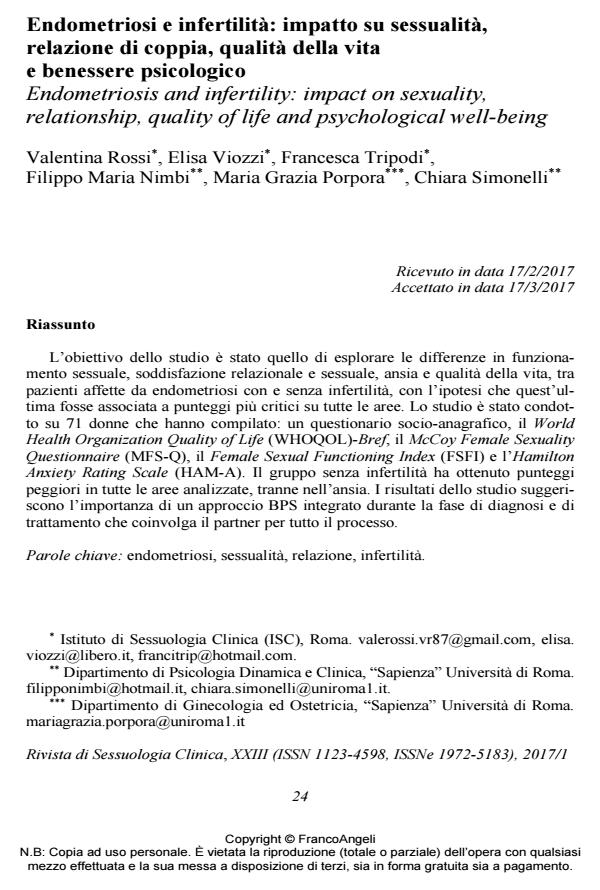Endometriosi e infertilità: impatto su sessualità, relazione di coppia, qualità della vita e benessere psicologico
Titolo Rivista RIVISTA DI SESSUOLOGIA CLINICA
Autori/Curatori Valentina Rossi, Elisa Viozzi, Francesca Tripodi, Filippo Maria Nimbi, Maria Grazia Porpora, Chiara Simonelli
Anno di pubblicazione 2017 Fascicolo 2017/1
Lingua Italiano Numero pagine 24 P. 24-47 Dimensione file 251 KB
DOI 10.3280/RSC2017-001002
Il DOI è il codice a barre della proprietà intellettuale: per saperne di più
clicca qui
Qui sotto puoi vedere in anteprima la prima pagina di questo articolo.
Se questo articolo ti interessa, lo puoi acquistare (e scaricare in formato pdf) seguendo le facili indicazioni per acquistare il download credit. Acquista Download Credits per scaricare questo Articolo in formato PDF

FrancoAngeli è membro della Publishers International Linking Association, Inc (PILA)associazione indipendente e non profit per facilitare (attraverso i servizi tecnologici implementati da CrossRef.org) l’accesso degli studiosi ai contenuti digitali nelle pubblicazioni professionali e scientifiche
L’obiettivo dello studio è stato quello di esplorare le differenze in funziona-mento sessuale, soddisfazione relazionale e sessuale, ansia e qualità della vita, tra pazienti affette da endometriosi con e senza infertilità, con l’ipotesi che quest’ul-tima fosse associata a punteggi più critici su tutte le aree. Lo studio è stato condot-to su 71 donne che hanno compilato: un questionario socio-anagrafico, il World Health Organization Quality of Life (WHOQOL)-Bref, il McCoy Female Sexuality Questionnaire (MFS-Q), il Female Sexual Functioning Index (FSFI) e l’Hamilton Anxiety Rating Scale (HAM-A). Il gruppo senza infertilità ha ottenuto punteggi peggiori in tutte le aree analizzate, tranne nell’ansia. I risultati dello studio suggeri-scono l’importanza di un approccio BPS integrato durante la fase di diagnosi e di trattamento che coinvolga il partner per tutto il processo.
Parole chiave:Endometriosi, sessualità, relazione, infertilità.
- Endometriosi e sessualità: aspetti psicologici ed emotivi associati alla sessualità Bruna Tellina, Maria Grazia Porpora, Chiara Simonelli, Filippo Maria Nimbi, in RIVISTA DI SESSUOLOGIA CLINICA 1/2019 pp.71
DOI: 10.3280/RSC2019-001004
Valentina Rossi, Elisa Viozzi, Francesca Tripodi, Filippo Maria Nimbi, Maria Grazia Porpora, Chiara Simonelli, Endometriosi e infertilità: impatto su sessualità, relazione di coppia, qualità della vita e benessere psicologico in "RIVISTA DI SESSUOLOGIA CLINICA" 1/2017, pp 24-47, DOI: 10.3280/RSC2017-001002